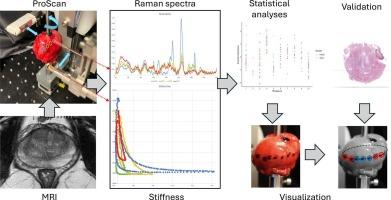Spectral and stiffness characterization of whole prostate gland to assist superficial cancer detection during radical prostatectomy
IF 4.6
2区 化学
Q1 SPECTROSCOPY
Spectrochimica Acta Part A: Molecular and Biomolecular Spectroscopy
Pub Date : 2025-09-24
DOI:10.1016/j.saa.2025.126992
引用次数: 0
Abstract
Prostate cancer treatment depends on whether the cancer exists only inside the gland or within the prostate capsule or on the outside surface of the gland. The presence on the outside surface indicates migration of the cancer to adjacent organs. This study presents a novel method for detecting prostate cancer (PCa) on the surface of excised prostate glands using Raman spectroscopy and stiffness measurements. The workflow involves assessing the location and extent of PCa via MRI before surgery, followed by 3D scanning of the excised prostate. Key positions on ten excised prostates, 211 positions with 56 deemed as cancer, are measured using Raman spectroscopy and stiffness probes. The results are mapped onto a digital representation of the prostate to aid surgical decision-making. Statistical analysis of the Raman data indicates that spectra could be divided into two components, one more related to cancer and one more related to normal tissue. A stiffness parameter was calculated from resonance measurements from the stiffness probe. The Raman components and stiffness parameters were converted to z-scores. Logistic generalized linear mixed modelling revealed that the stiffness parameter was statistically associated with cancer presence in prostate regions (p = 0.009). The scanning equipment is easy to handle and makes further larger studies possible. This method holds promise for providing real-time support during surgery, reducing the need for post-surgical therapies and minimizing patient distress.

在根治性前列腺切除术中,全前列腺的光谱和硬度特征有助于浅表癌的检测。
前列腺癌的治疗取决于癌症是只存在于腺体内部,还是存在于前列腺囊内,还是存在于腺体的外表面。肿瘤外表面的存在表明癌细胞已转移到邻近器官。本研究提出了一种利用拉曼光谱和刚度测量在切除前列腺表面检测前列腺癌(PCa)的新方法。工作流程包括在手术前通过MRI评估前列腺癌的位置和范围,然后对切除的前列腺进行3D扫描。使用拉曼光谱和硬度探针测量10个切除前列腺的关键位置,其中211个位置,56个被认为是癌症。结果被映射到前列腺的数字表示上,以帮助手术决策。拉曼光谱数据的统计分析表明,光谱可以分为两个部分,一个与癌症有关,另一个与正常组织有关。从刚度探头的共振测量中计算出刚度参数。拉曼分量和刚度参数转换为z分数。Logistic广义线性混合模型显示,刚度参数在统计学上与前列腺癌的存在相关(p = 0.009)。扫描设备易于操作,使进一步的大规模研究成为可能。这种方法有望在手术过程中提供实时支持,减少术后治疗的需要,并最大限度地减少患者的痛苦。
本文章由计算机程序翻译,如有差异,请以英文原文为准。
求助全文
约1分钟内获得全文
求助全文
来源期刊
CiteScore
8.40
自引率
11.40%
发文量
1364
审稿时长
40 days
期刊介绍:
Spectrochimica Acta, Part A: Molecular and Biomolecular Spectroscopy (SAA) is an interdisciplinary journal which spans from basic to applied aspects of optical spectroscopy in chemistry, medicine, biology, and materials science.
The journal publishes original scientific papers that feature high-quality spectroscopic data and analysis. From the broad range of optical spectroscopies, the emphasis is on electronic, vibrational or rotational spectra of molecules, rather than on spectroscopy based on magnetic moments.
Criteria for publication in SAA are novelty, uniqueness, and outstanding quality. Routine applications of spectroscopic techniques and computational methods are not appropriate.
Topics of particular interest of Spectrochimica Acta Part A include, but are not limited to:
Spectroscopy and dynamics of bioanalytical, biomedical, environmental, and atmospheric sciences,
Novel experimental techniques or instrumentation for molecular spectroscopy,
Novel theoretical and computational methods,
Novel applications in photochemistry and photobiology,
Novel interpretational approaches as well as advances in data analysis based on electronic or vibrational spectroscopy.

 求助内容:
求助内容: 应助结果提醒方式:
应助结果提醒方式:


